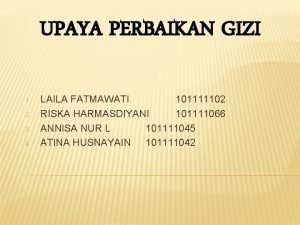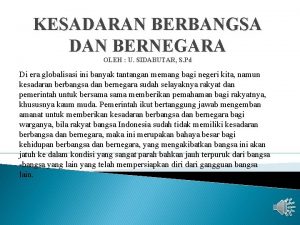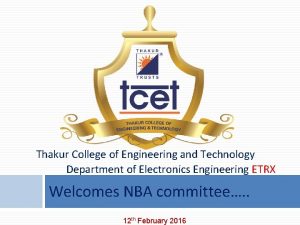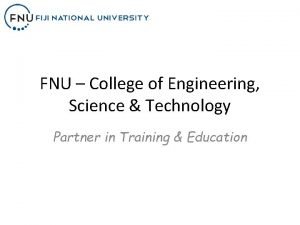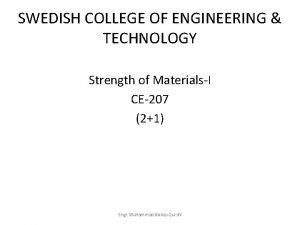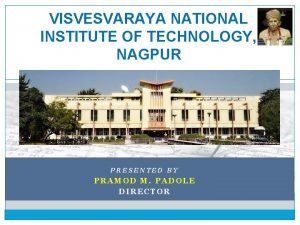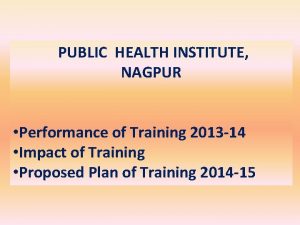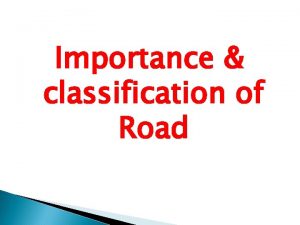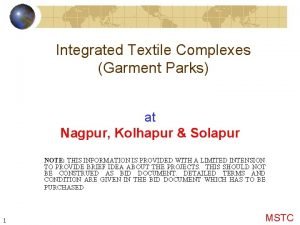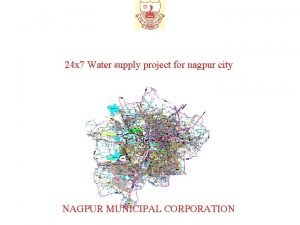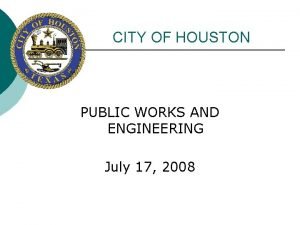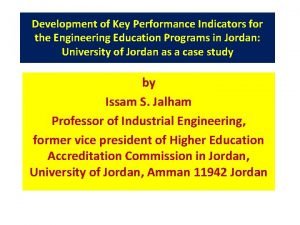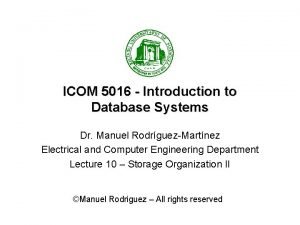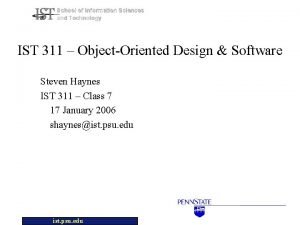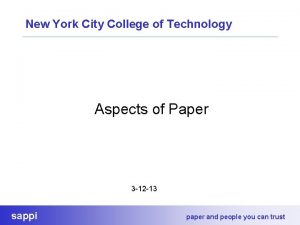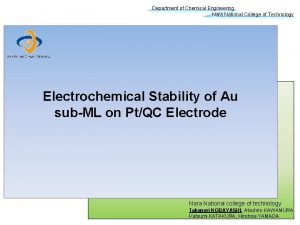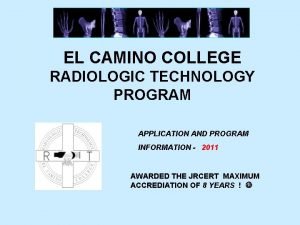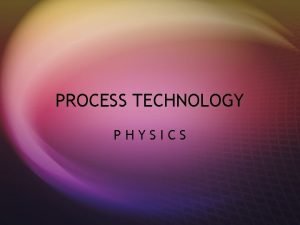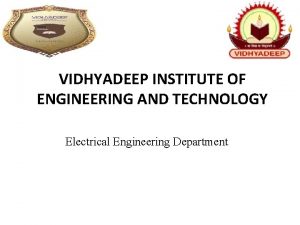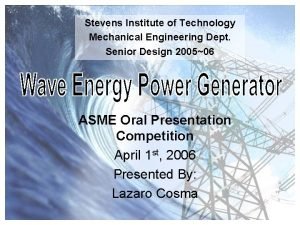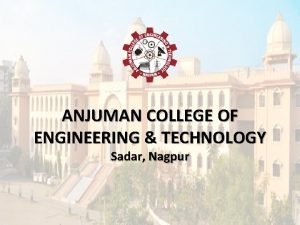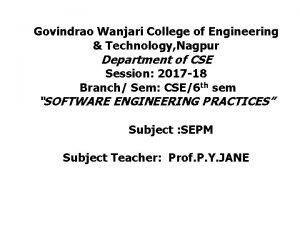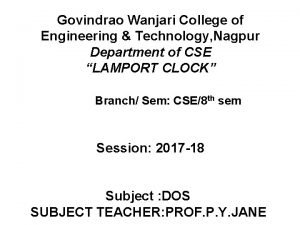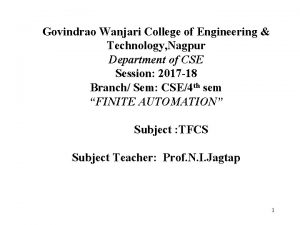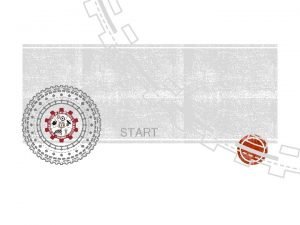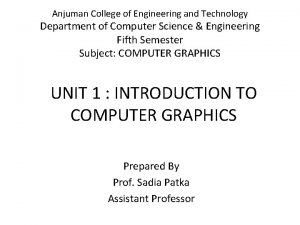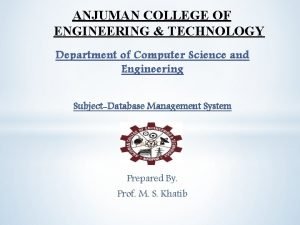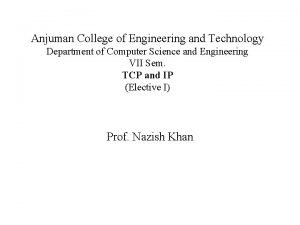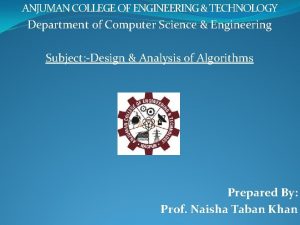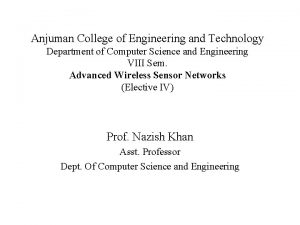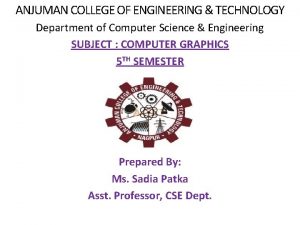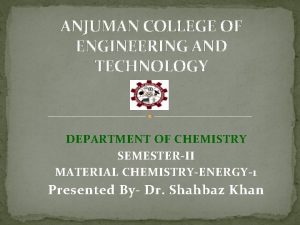ANJUMAN COLLEGE OF ENGINEERING TECHNOLOGY Sadar Nagpur DEPARTMENT




















































- Slides: 52

ANJUMAN COLLEGE OF ENGINEERING & TECHNOLOGY Sadar, Nagpur

DEPARTMENT OF MECHANICAL ENGINEERING

A Presentation on Air Compressor Subject Teacher: Prof. Nafees P. Khan Subject: Energy Conversion-II Semester: 7 th Sem B. E

CO attended CO 704 T 1: Explain the working of Reciprocating compressor and evaluate the performance parameters of Single stage & multistage Reciprocating air compressor CO 704 T 2: Compare reciprocating and rotary compressor, explain, classify rotary compressor

Air Compressors COMPRESSOR – A device which takes a definite quantity of fluid ( usually gas, and most often air ) and deliver it at a required pressure. Air Compressor – 1) Takes in atmospheric air, 2) Compresses it, and 3) Delivers it to a storage vessel ( i. e. Reservoir ). Compression requires Work to be done on the gas, Compressor must be driven by some sort of Prime Mover ( i. e. Engine )

How they are different from pumps? • Major difference is that compressors handles the gases and pumps handles the liquids. • As gases are compressible, the compressor also reduces the volume of gas. • Liquids are relatively incompressible; while some can be compressed

Applications Compressors have many everyday uses, such as in : • Air conditioners, (car, home) • Pneumatic devices • Home and industrial refrigeration • Hydraulic compressors for industrial machines • Air compressors for industrial manufacturing

Classification of Compressor classification can be described by following flow chart:

Dynamic Compressors The dynamic compressor is continuous flow compressor is characterized by rotating impeller to add velocity and thus pressure to fluid. It is widely used in chemical and petroleum refinery industry for specific services. There are two types of dynamic compressors § Centrifugal Compressor § Axial Flow Compressor

Centrifugal Compressors • Achieves compression by applying inertial forces to the gas by means of rotating impellers. • It is multiple stage ; each stage consists of an impeller as the rotating element and the stationary element, i. e. diffuser • Fluid flow enters the impeller axially and discharged radially • The gas next flows through a circular chamber (diffuser), where it loses velocity and increases pressure.

Axial Flow Compressor • Working fluid principally flows parallel to the axis of rotation. • The energy level of air or gas flowing through it is increased by the action of the rotor blades which exert a torque on the fluid • Have the benefits of high efficiency and large mass flow rate • Require several rows of airfoils to achieve large pressure rises making them complex and expensive

Positive displacement Compressor Positive displacement compressors causes movement by trapping a fixed amount of air then forcing (displacing) that trapped volume into the discharge pipe. It can be further classified according to the mechanism used to move air. Ø Rotary Compressor Ø Reciprocating compressor

Positive displacement Compressor Air Compressors Reciprocating Rotary Centrifugal No. of Stages No. of Sides of Piston for Compression in operation Single – stage Multi - stage Single – acting Double - Acting

Rotary Compressor • The gas is compressed by the rotating action of a roller inside a cylinder. • The roller rotates off-centre around a shaft so that part of the roller is always in contact with the cylinder. • Volume of the gas occupies is reduced and the refrigerant is compressed. • High efficient as sucking and compressing refrigerant occur simultaneously.

Reciprocating Compressor It is a positive-displacement compressor that • Uses pistons driven by a crankshaft to deliver gases at high pressure. • The intake gas enters the suction manifold, then flows into the compression cylinder • It gets compressed by a piston driven in a reciprocating motion via a crankshaft, • Discharged at higher pressure

Reciprocating Compressor - Detailed Analysis Principle of Operation u u Fig. shows single-acting piston actions in the cylinder of a reciprocating compressor. The piston is driven by a crank shaft via a connecting rod. At the top of the cylinder are a suction valve and a discharge valve. A reciprocating compressor usually has two, three, four, or six cylinders in it.

Reciprocating Compressor - Working

Reciprocating Compressor – Equation for Work P 2 3 2’ 2 2” Pressure (Isothermal) (Adiabatic) P 1 4 1 (Polytropic) V 2 V 1 Volume Operations : 4 – 1 : Volume V 1 of air aspirated into Compressor, at P 1 and T 1. 1 – 2 : Air compressed according to PVn = Const. from P 1 to P 2. → Temp increase from T 1 to T 2. 2 – 3 : Compressed air at P 2 and V 2 with temperature T 2 is delivered.

Reciprocating Compressor – Equation for Work During Compression, due to the excess temperature above surrounding, the air will exchange the heat to the surrounding. Compression Index, n is always less than γ, the adiabatic index. As Compressor is a work consuming device, every effort is desired to reduce the work. Work done = Area under P-V curve 1 – 2” : Adiabatic Compression = Max. Work. 1 – 2 : Polytropic Compression 1 – 2’ : Isothermal Compression = Min. Work.

Reciprocating Compressor – Equation for Work Thus, comparison between the Isothermal Work and the Actual Work is important. Isothermal Efficiency, ηiso = Isothermal Work Actual Work Thus, more the Isothermal Efficiency, more the actual compression approaches to the Isothermal Compression. Actual Work = Wact = Area 4 -1 -2 -3 -4 P 2 3 2’ 2 2” Wact = Area (4 -1) – Area (1 -2) – Area (2 -3) (Isothermal) (Adiabatic) P 1 4 1 (Polytropic) V 2 V 1

Reciprocating Compressor – Equation for Work P 2 3 2’ 2 2” (Isothermal) (Adiabatic) P 1 4 1 (Polytropic) V 2 V 1 Now,

Reciprocating Compressor – Equation for Work P 2 3 2’ 2 2” (Isothermal) (Adiabatic) P 1 4 1 (Polytropic) V 2 V 1 Delivery Temperature, The solution of this equation is always negative. This shows that Work is done ON the Compressor.

Reciprocating Compressor – Equation for Work Clearance Volume : P 2 6 3 2 Volume that remains inside the cylinder after the piston reaches the end of its inward stroke. P 1 5 4 V 3 Clearance Volume, V 3=Vc V 4 1 V 1 Effective Swept Volume, V 1 -V 4 Swept Volume, V 1 -V 3=Vs Total Volume, V 1 Thus, Effective Stroke Volume = V 1 – V 4 Actual Work = Wact = Area 1 -2 -3 -4 Wact = Area (5 -1 -2 -6) – Area (5 -4 -3 -6)

Reciprocating Compressor – Equation for Work P 2 P 1 6 3 2 5 4 V 3 Clearance Volume, V 3=Vc V 4 1 V 1 Effective Swept Volume, V 1 -V 4 Swept Volume, V 1 -V 3=Vs Total Volume, V 1 But, P 4 = P 1 and P 3 = P 2

Reciprocating Compressor – Volumetric Efficiency : Ratio of free air delivered to the displacement of the compressor. P 2 P 1 6 3 2 Ratio of Effective Swept Volume to Swept Volume. Presence of Clearance Volumetric Efficiency less than 1. ( 60 – 85 % ) 5 4 V 3 Clearance Volume, V 3=Vc V 4 1 Volumetric Efficiency = V 1 = Effective Swept Volume, V 1 -V 4 Swept Volume, V 1 -V 3=Vs Clearance Ratio = Total Volume, V 1 = Effective Swept Volume V 1 – V 4 V 1 – V 3 Clearance Volume Swept Volume Vc = γ ( 4 – 10 % ) Vs

Reciprocating Compressor – Volumetric Efficiency ↑ Pr. Ratio ↑ Effect of Clearance Volume …. Clearance air expansion through greater volume before intake P 2 6 3 2 Cylinder bore and stroke is fixed. Effective Swept Volume (V 1 – V 4) ↓ with ↑ Pr. Ratio ↓ Volumetric Efficiency P 1 5 4 V 3 V 4 1 V 1 Effective Swept Volume, V 1 -V 4 Clearance Volume, V 3=Vc Swept Volume, V 1 -V 3=Vs Total Volume, V 1

Reciprocating Compressor – Volumetric Efficiency 6 3 P 2 5 2 4 P 1 V 3 V 4 1 V 1 Effective Swept Volume, V 1 -V 4 Clearance Volume, V 3=Vc Swept Volume, V 1 -V 3=Vs Total Volume, V 1

Reciprocating Compressor – Actual P-V Diagram Receiver Pressure P 2 P 1 3 2 1 -2 -3 -4 -1 : Theoretical P-V Diagram. At 4, inlet valve does not open due to : 1. There must be a pressure difference across the valve to open. 2. Inlet valve inertia. Pr. Drop continues till sufficient level Atmospheric Pressure for valve to force its seat. 4 Valve Bounce Intake Depression 1 Some valve bounce is set (wavy line). Eventually, the pressure sets down at a level lower than atmospheric pressure. This negative pressure difference is known as Intake Depression. Similar situation appears at 2, i. e. at the start of the delivery. Pressure rise, followed by valve bounce and then pressure settles at a level higher than the delivery pressure level. Air delivery to a tank / receiver, hence, generally known as Receiver Pressure.

Reciprocating Compressor – F. A. D. Free Air Delivery (F. A. D. ) : If the volume of the air compressor is reduced to atmospheric temperature and pressure, this volume of air is called FAD (m 3/min) Delivered mass of air = intake mass of air If clearance volume is neglected Where

Reciprocating Compressor – Multistage High Pressure required by Single – Stage : 1. Requires heavy working parts. 2. Has to accommodate high pressure ratios. 3. Increased balancing problems. 4. High Torque fluctuations. 5. Requires heavy Flywheel installations. This demands for MULTI – STAGING…!!

Why multistage compressor? • High temp rise leads into limitation for the maximum achievable pressure rise. • Discharge temperature shall not exceed 150ºC and should not exceed 1350 C for hydrogen rich services • A multistage compressor compresses air to the required pressure in multiple stages. • Intercoolers are used in between each stage to removes heat and decrease the temperature of gas so that gas could be compressed to higher pressure without much rise in temperature

Reciprocating Compressor – Multistage Series arrangement of cylinders, in which the compressed air from earlier cylinder (i. e. discharge) becomes the intake air for the next cylinder (i. e. inlet). L. P. = Low Pressure Intercooler Air Delivery I. P. = Intermediate Pressure H. P. = High Pressure L. P. Cylinder Intercooler Air Intake H. P. Cylinder Intercooler : Compressed air is cooled between cylinders.

Reciprocating Compressor – Multistage Delivery Pr. 6 P 3 or Pd 3 9 5 Without Intercooling H. P. Intermediate Pr. 7 P 2 Perfect Intercooling Single – stage cycle : 8 -1 -5 -6 Without Intercooling : L. P. : 8 -1 -4 -7 H. P. : 7 -4 -5 -6 4 2 L. P. Intake Pr. 8 P 1 or Ps Overall Pr. Range : P 1 – P 3 1 With Intercooling : L. P. : 8 -1 -4 -7 H. P. : 7 -2 -3 -6 Volume Perfect Intercooling : After initial compression in L. P. cylinder, air is cooled in the Intercooler to its original temperature, before entering H. P. cylinder i. e. T 2 = T 1 OR Points 1 and 2 are on SAME Isothermal line.

Reciprocating Compressor – Multistage Ideal Conditions for Multi – Stage Compressors : A. Single – Stage Compressor : 6 3 9 5 Single – stage cycle : 8 -1 -5 -6 H. P. 7 4 2 Delivery Temperature, L. P. 8 1

Reciprocating Compressor – Multistage B. Two – Stage Compressor (Without Intercooling) : 6 3 9 Without Intercooling : L. P. : 8 -1 -4 -7 H. P. : 7 -4 -5 -6 5 H. P. 7 4 2 L. P. 8 1 Without Intercooling This is SAME as that of Work done in Single – Stage. Delivery Temperature also remains SAME.

Reciprocating Compressor – Multistage C. Two – Stage Compressor (With Perfect Intercooling) : 6 3 9 With Intercooling : L. P. : 8 -1 -4 -7 -8 H. P. : 7 -2 -3 -6 -7 5 H. P. 7 4 2 L. P. 8 1 Delivery Temperature,

Reciprocating Compressor – Multistage C. Two – Stage Compressor (With Perfect Intercooling) : 6 3 9 5 With Intercooling : L. P. : 8 -1 -4 -7 -8 H. P. : 7 -2 -3 -6 -7 H. P. 7 Now, T 2 = T 1 4 P 2 V 2 = P 1 V 1 2 L. P. 8 1 Also P 4 = P 2 Shaded Area 2 -4 -5 -3 -2 : Work Saving due to Intercooler…!!

Reciprocating Compressor – Multistage Condition for Min. Work : 6 3 9 Intermediate Pr. P 2 → P 1 : Area 2 -4 -5 -3 -2 → 0 Intermediate Pr. P 2 → P 3 : Area 2 -4 -5 -3 -2 → 0 5 There is an Optimum P 2 for which Area 2 -4 -5 -3 -2 is maximum, H. P. i. e. Work is minimum…!! 7 4 2 L. P. 8 1 For min. Work,

Reciprocating Compressor – Multistage Condition for Min. Work : 3 6 9 5 H. P. 7 2 8 4 L. P. 1

Reciprocating Compressor – Multistage P 2 obtained with this condition (Pr. Ratio per stage is equal) is the Ideal Intermediate Pr. Which, with Perfect Intercooling, gives Minimum Work, Wmin. Equal Work per cylinder…!!

Reciprocating Compressor – Efficiency Isothermal work done / cycle = Area of P – V Diagram = P 1 V 1 loge(P 2/P 1) Isothermal Power = P 1 V 1 loge(P 2/P 1) N 60 X 1000 k. W Indicated Power : Power obtained from the actual indicator card taken during a test on the compressor. Compressor Efficiency = Isothermal Power Indicated Power Isothermal Efficiency = Isothermal Power Shaft Power NOTE : Shaft Power = Brake Power required to drive the Compressor.

Reciprocating Compressor – Efficiency Adiabatic Efficiency : Ratio of Power required to drive the Compressor; compared with the area of the hypothetical Indicator Diagram; assuming Adiabatic Compression. Mechanical Efficiency : Ratio of mechanical output to mechanical input. Mechanical Efficiency, ηmech = Indicated Power Shaft Power

Reciprocating Compressor – Efficiency How to Increase Isothermal Efficiency ? A. Spray Injection : Assimilation of water into the compressor cylinder towards the compression stroke. Object is to cool the air for next operation. Demerits : 1. Requires special gear for injection. 2. Injected water interferes with the cylinder lubrication. 3. Damage to cylinder walls and valves. 4. Water must be separated before delivery of air. B. Water Jacketing : Circulating water around the cylinder to help for cooling the air during compression.

Reciprocating Compressor – Efficiency How to Increase Isothermal Efficiency ? C. Inter – Cooling : For high speed and high Pr. Ratio compressors. Compressed air from earlier stage is cooled to its original temperature before passing it to the next stage. D. External Fins : For small capacity compressors, fins on external surfaces are useful. E. Cylinder Proportions : Short stroke and large bore provides much greater surface for cooling. Cylinder head surface is far more effective than barrel surface.

Reciprocating Compressor – Efficiency Clearance Volume : Consists of two spaces. 1. Space between cylinder end & the piston to allow for wear. 2. Space for reception of valves. High – class H. P. compressors : Clearance Vol. = 3 % of Swept Vol. : Lead (Pb) fuse wire used to measure the gap between cylinder end and piston. Low – grade L. P. compressors : Clearance Vol. = 6 % of Swept Vol. : Flattened ball of putty used to measure the gap between cylinder end and piston. Effect of Clearance Vol. : Vol. taken in per stroke < Swept Vol. ↑ Size of compressor ↑ Power to drive compressor.

Reciprocating Compressor – Work Done Assumption : Compression and Expansion follow same Law. Work / cycle = Area 1 -2 -3 -4 -1 P 2 6 3 2 P 3 = P 2 and P 4 = P 1 5 4 V 3 V 4 1 V 1 Effective Swept Volume, V 1 -V 4 Clearance Volume, V 3=Vc Swept Volume, V 1 -V 4=Vs Total Volume, V 1

Reciprocating Compressor – Work Done P 2 6 3 2 m 1 is the actual mass of air delivered. P 1 5 4 V 3 V 4 1 V 1 Effective Swept Volume, V 1 -V 4 Clearance Volume, V 3=Vc Swept Volume, V 1 -V 4=Vs Total Volume, V 1 Work done / kg of air delivered :

How to select a particular type of compressor ? Graph showing operating regions of various compressors Taken from PIP REEC 001 Compressor Selection Guidelines

Table showing operating conditions of various compressors Taken from PIP REEC 001 Compressor Selection Guidelines

Advantages and Disadvantages of Dynamic compressors Advantages Disadvantages Centrifugal • Wide operating range • High reliability • Low Maintenance • Instability at reduced flow • Sensitive to gas composition change Axial • High Capacity for given size • High efficiency • Heavy duty • Low maintenance • Low Compression ratios • Limited turndown Dynamic Compressors

Advantages and Disadvantages of Positive displacement compressors Advantages Disadvantages Reciprocating • Wide pressure ratios • High efficiency • Heavy foundation required • Flow pulsation • High maintenance Diaphragm • Very high pressure • Low flow • No moving seal • Limited capacity range • Periodic replacement of diaphragm Screw • Wide application • High efficiency • High pressure ratio • Expensive • Unsuitable for corrosive or dirty gases Positive displacement compressor

Thank You
 The silenced by nadia anjuman
The silenced by nadia anjuman Manajemen risiko
Manajemen risiko Struktur organisasi manajemen risiko perusahaan
Struktur organisasi manajemen risiko perusahaan Keluarga sadar gizi
Keluarga sadar gizi Asas tiada pidana tanpa kesalahan
Asas tiada pidana tanpa kesalahan Rela berkorban nyawa
Rela berkorban nyawa Usaha sadar adalah
Usaha sadar adalah Thakur college of engineering and technology
Thakur college of engineering and technology Fnu engineering courses
Fnu engineering courses Animals that eat both plants and animals
Animals that eat both plants and animals Swedish college of engineering and technology
Swedish college of engineering and technology Visvesvaraya technological university nagpur
Visvesvaraya technological university nagpur Public health institute nagpur
Public health institute nagpur Mount litera zee school learning resources pdf
Mount litera zee school learning resources pdf Ddu gky nagpur
Ddu gky nagpur Classification of roads by nagpur road plan
Classification of roads by nagpur road plan Nagpur garment industry
Nagpur garment industry Classification of roads by nagpur road plan
Classification of roads by nagpur road plan Nmc water bill nagpur
Nmc water bill nagpur Oklahoma department of career and technology education
Oklahoma department of career and technology education Department of information technology
Department of information technology Principal certification oklahoma
Principal certification oklahoma Department of electronics & information technology
Department of electronics & information technology Latest electronics and information technology in odisha
Latest electronics and information technology in odisha Pasadena city college police department
Pasadena city college police department Electrical engineering department
Electrical engineering department Engineering department hotel
Engineering department hotel City of houston design manual
City of houston design manual Sample kpi for project engineer
Sample kpi for project engineer Department of information engineering university of padova
Department of information engineering university of padova Department of information engineering university of padova
Department of information engineering university of padova Tum
Tum Mse iitd
Mse iitd University of bridgeport engineering
University of bridgeport engineering University of bridgeport computer engineering
University of bridgeport computer engineering Computer engineering department
Computer engineering department Ucla systems engineering
Ucla systems engineering University of sargodha engineering department
University of sargodha engineering department Ist 311
Ist 311 Sappi paper
Sappi paper Nara images
Nara images El camino college radiologic technology program
El camino college radiologic technology program Sheridan college architectural technology
Sheridan college architectural technology Dublin institute of technology college of business
Dublin institute of technology college of business Trent global college of technology and management
Trent global college of technology and management Lee college process technology
Lee college process technology Kingsmead intranet
Kingsmead intranet Wake tech admissions
Wake tech admissions Early college high school at midland college
Early college high school at midland college Vidhyadeep institute of engineering and technology
Vidhyadeep institute of engineering and technology Fcc office of engineering and technology
Fcc office of engineering and technology Reel to reel institute
Reel to reel institute A layered technology in software engineering
A layered technology in software engineering



